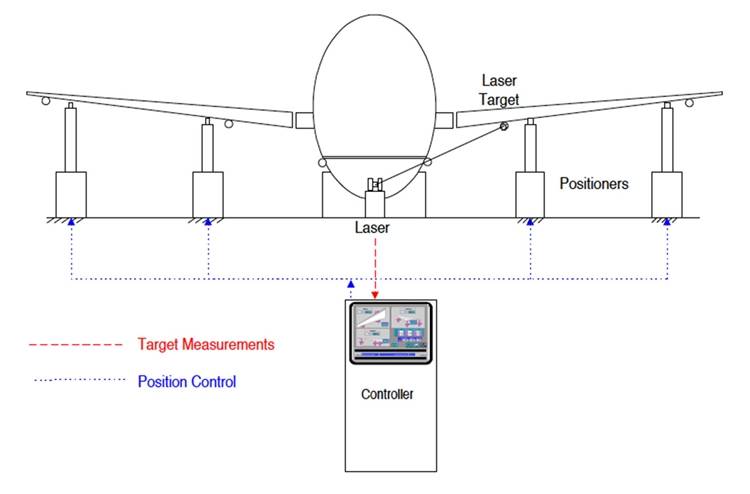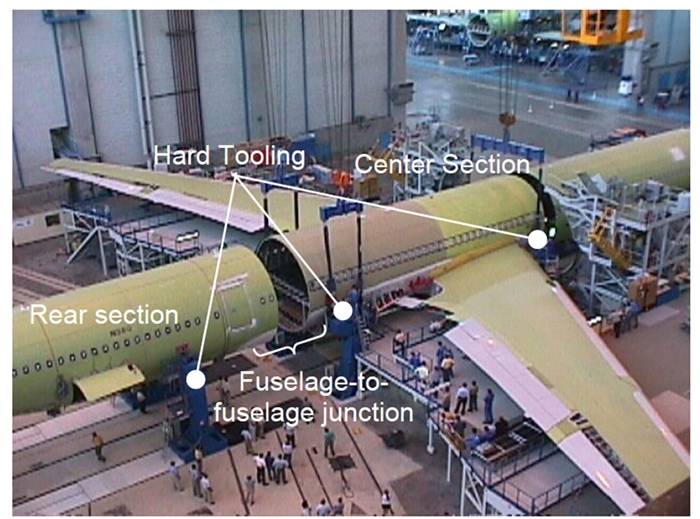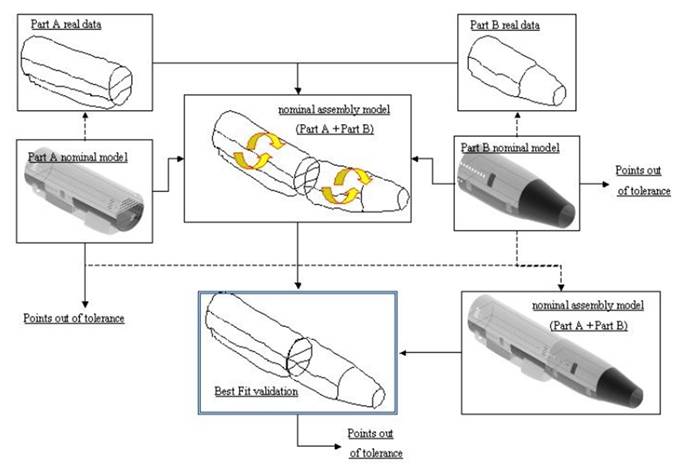Final Assembly of Airbus 400M
In my last blog post, I talked about measurement assisted assembly (MAA). Measurement Assisted Assembly is a key operation for the reduction of time in aerospace assembly, which can account for as much as 40% of aircraft manufacturing costs. In this post I will present an interesting example of MAA: Assembly of aircraft through the guidance of measurement devices.
The techniques detailed in this post are quite similar and follow the same principle: The aerospace structure is approximately positioned in an assembly and then measured. Its position is then corrected with regard to the obtained measurements until it has the optimal position.
AINT Measurement Assisted Assembly Method: Measure, Align and Position with Motorized Positioners

Diagram of AINT measurement assisted assembly method: Measure, Align and Position with Motorized Positioners
An impressive example of this method is offered by the Advanced Integration Technology (AINT) company. This company uses similar methodologies in both the Boeing 787 Dreamliner and F35 Joint Strike Fighter assembly projects.
A typical automobile is composed of approximately 20,000 components, while a Boeing 777 is composed of 4 million.
In this case, the Measurement Assisted Assembly System is comprised of three main components:
- Measurement system: Laser tracker
- Controller: Software that provides feedback to positioners
- Positioners
The MAA system designed by AINT can be summarized as follows:
- Aircraft structure is placed on motorized positioners.
- A laser tracker measures the position of laser targets placed in different places on the aerostructures.
- The laser tracker provides feedback on the real position of the targets to the technician through a GUI interface.
- The technician aligns the aircraft structure by maneuvering the motorized positioners with the help of a joystick.
In general, a spot weld gun in car assembly is positioned within +/- 1.2 mm (Axelsson, 2002); while a drilling machine in aircraft assembly requires positioning within +/- 0.2 mm and sometimes with higher tolerance.
AIRBUS Measurement Assisted Assembly Method: Measure, Align and Set the Jigs Accordingly

AIRBUS Method: Measure, Align and Set the Jigs Accordingly
In the case of Airbus, a fuselage assembly is performed by using Measurement Assisted Assembly in their final assembly line in Toulouse. This method uses:
- A laser tracker system
- An optimization software

Airbus fuselage assembly process flowchart
First, the laser tracker measures the real positions of the assembly points on the fuselage sections. Next, the software calculates the optimum positions for alignment of the fuselage sections. The jig positions are then set up accordingly by technicians. This method does not use motorized positioners for the final fixture adjustment in contrast to the assembly method used by AINT in the previous example.
The manufacturing process for Airbus wings requires the drilling of over 40 million holes in aircraft structures per annum. The majority of these holes, approximately 80% of the total, are drilled manually.
Measurement Assisted Assembly (MAA) can be very beneficial in reducing the assembly times of aerospace structures. In this post, we saw two different techniques of performing MAA:
- AINT Method: Measure, Align and Position with Motorized Positioners – Measurements are performed with laser trackers. Following the feedback of laser trackers, aerospace structures are aligned and positioned accordingly with motorized positioners.
- AIRBUS Method: Measure, Align and Set the Jigs Accordingly – Measurements are carried out through laser trackers. Following the feedback of laser trackers, alignment and positioning are realized manually by setting the jigs accordingly.
Advantages of Metrology Assisted Assembly
- Reduction of cost of tooling
- Increase in repeatability of assembly
- Improvement in the achievement of tolerances.
Until now, laser trackers were the instruments of choice for aerospace assembly, however the developments in new instruments such as iGPS and LIDAR can offer new possibilities in the future. The arrival of new measurement instruments could mean the complete revision of existing assembly methods.
